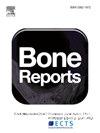Ribosylation-induced increase in advanced glycation end products has limited impacts on mechanical properties in human cortical bone
IF 2.6
Q3 ENDOCRINOLOGY & METABOLISM
引用次数: 0
Abstract
Diabetes affects over 38 million individuals in the U.S. and is associated with a heightened risk of fractures despite normal or elevated bone mineral density (BMD). This increased fracture susceptibility may be linked to the accumulation of advanced glycation end products (AGEs), which are theorized to compromise bone quality by stiffening the collagen network, leading to tissue embrittlement. In this study, the mechanical effects of AGE accumulation in human cortical bone were evaluated in vitro. Bone beams, derived from a human femur, were incubated in a ribose solution to induce AGE accumulation, while control beams were incubated in a control solution. Dynamic Mechanical Analysis (DMA) and three-point bending tests were conducted to assess the mechanical properties of the bone beams. Fluorescent AGE analysis was performed to quantify and compare AGE levels between the groups. The study found no significant differences in mechanical properties between the control and ribose-treated groups, despite a significant elevation in normalized AGE content in the ribose group. These results suggest that AGE accumulation may have a weaker impact on the mechanical properties of human bone than previously hypothesized. However, this study emphasizes the need for further research to explore the relationship between AGE accumulation and bone quality. Understanding this relationship is crucial for developing strategies to reduce fracture risk in populations with high AGE levels, such as diabetic and elderly individuals.
核糖基化诱导的晚期糖基化终产物的增加对人类皮质骨的力学性能影响有限
在美国,糖尿病影响着超过3800万人,尽管骨密度(BMD)正常或升高,但糖尿病与骨折风险增加有关。这种增加的骨折易感性可能与晚期糖基化终产物(AGEs)的积累有关,理论上,AGEs会通过硬化胶原网络而损害骨质量,导致组织脆化。在本研究中,我们在体外评估了AGE在人皮质骨中蓄积的力学效应。来源于人股骨的骨梁在核糖溶液中孵育以诱导AGE积累,而对照梁在对照溶液中孵育。通过动态力学分析(DMA)和三点弯曲试验来评估骨梁的力学性能。采用荧光AGE分析来量化和比较各组之间的AGE水平。研究发现,尽管核糖组的标准化AGE含量显著升高,但对照组和核糖处理组之间的机械性能没有显著差异。这些结果表明,AGE的积累对人体骨骼力学性能的影响可能比先前假设的要弱。然而,本研究强调需要进一步研究AGE积累与骨质量的关系。了解这种关系对于制定策略来降低高AGE水平人群(如糖尿病和老年人)的骨折风险至关重要。
本文章由计算机程序翻译,如有差异,请以英文原文为准。
求助全文
约1分钟内获得全文
求助全文
来源期刊

Bone Reports
Medicine-Orthopedics and Sports Medicine
CiteScore
4.30
自引率
4.00%
发文量
444
审稿时长
57 days
期刊介绍:
Bone Reports is an interdisciplinary forum for the rapid publication of Original Research Articles and Case Reports across basic, translational and clinical aspects of bone and mineral metabolism. The journal publishes papers that are scientifically sound, with the peer review process focused principally on verifying sound methodologies, and correct data analysis and interpretation. We welcome studies either replicating or failing to replicate a previous study, and null findings. We fulfil a critical and current need to enhance research by publishing reproducibility studies and null findings.
 求助内容:
求助内容: 应助结果提醒方式:
应助结果提醒方式:


